Li Rui (李瑞) is a painter of Hani descent, a minority group that inhabits the southern part of China and northern Southeast Asia. Growing up in the Hani prefecture of Yunnan Province, Li was raised in a rich cultural environment of traditional arts and crafts, including embroidery, painting and religious calligraphy. He began studying Chinese ink painting at a young age and was introduced to oil painting and western art concepts while attending college in Kunming. Li’s oil paintings often depict poetic landscapes that reflect his insightful observations of nature intertwined with childhood memories and literary quotations. His double solo exhibition, Yun Gu Ran (雲谷然), at Soka Art Center’s Taipei and Tainan galleries features a series of recent paintings that continue his introspective journey into the wilderness. Wandering Alone depicts a cluster of faded trees in a luscious field of grass. The moon hides behind the trees while bird-like swabs of white paint perch on the tree branches. Come and Go: Flower Bloom and Wilt is a more ominous narrative that features a rosy flower against an abstract shroud of gray smoke in a barren landscape. For more information about the two shows, visit Soka Art Center’s Web site: www.soka-art.com.
■ Soka Art Center, 350, Sec 2, Tiding Boulevard, Taipei City (台北市堤頂大道二段350號), tel: (02) 2533-9658. Open Tuesdays to Sundays from 1pm to 7pm
■ Taipei show until June 17; Tainan show until May 27
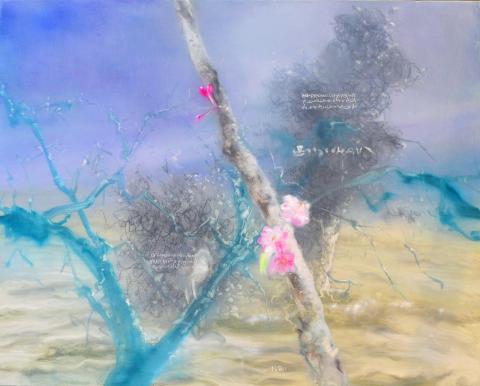
Photo Courtesy of Soka Art Center
Chi Chien (齊簡) is a Taiwanese artist who works across diverse media to explore the boundaries of art as a system, a medium and an action. His solo show, Live — There and Then / Then and There (這裡那裡), currently on view at VT Art Salon, can be considered both an art exhibition and a month-long performance. The project features a series of performative actions, photography, film and installations that respond to the concept of live broadcast and body politics. A nude female model is present in the gallery space; she moves along the walls with no pre-scripted instructions. She instinctively responds to the gallery, responding to its physicality, while sometimes diverting her attention to the toy cars and paper boxes placed in the space. “She is the object to be gazed at … while she [develops] a private world [in which] she is alone with the objects,” writes curator Fan Yen-hsiang in the exhibition preface. The show also features a number of installations, including Bamboo House, a minimalist pavilion made with bamboo shoots that is labeled with a warning sign “do not cross the yellow line.” Legal consists of two wooden signs printed with the words: Warning: You are breaking the law. In this show, the artist strives to depict “everyday life in a more theatrical way… but does not includes the elements of theater,” writes Fang.
■ VT Artsalon (非常廟藝文空間), b1, 17, Ln 56, Sec 3, Xinsheng N Rd, Taipei City (台北市新生北路三段56巷17號B1), tel: (02) 2597-2525. Open Tuesdays to Fridays from 11:30am to 7pm, Saturdays 1:30pm to 9pm
■ Until June 16
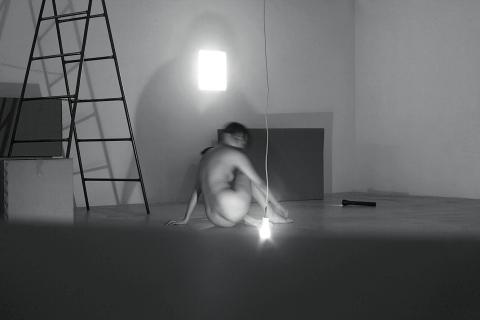
Photo Courtesy of VT Art Salon
Lian Yi-An (連苡安) is a young Taiwanese artist and a fine arts graduate student at Tainan National University of the Arts. Her work is mostly two-dimensional and often revealing of her insightful observations of the mundane aspects of everyday life. Lian’s solo exhibition, Plastic Bags in the Earth, at Tainan’s Mumu Art Space, features 18 petite paintings on silk and two videos created over the past two years. Each work reveals clues to a story, but these clues merely provide secondary information to the main narrative, which is absent from the show. Lian is interested in the neglected parts of a story that are left out of the frame and seeks to experiment with alternative means of narration. It “feels like something is over there, [when] there is actually nothing…[but] what is this so-called nothing?” writes the artist in a press release. Highlights in the show include Black Sweat, a closely framed picture of the back of a person; an ink stain drips from the person’s polka-dotted shirt collar and spreads down to the person’s faded gray jacket. Tiny Shoulders depicts a similar cropped view of a person wearing a blue sweater and white collared shirt. Color Mixing depicts a pair of hands tainted by dark ink; the right hand touches the resting left hand as if trying to soothe or rub of the ink.
■ Mumu Gallery (木木藝術), 50, Minde Rd, Tainan City (台南市民德路50號), tel: (06) 252-6121. Open Mondays to Saturdays from 10am to 6pm
■ June 16
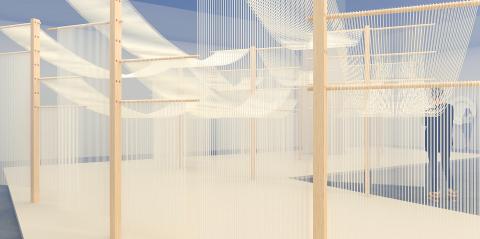
Photo Courtesy of TKG+
Jiang Dahai (江大海) is a Chinese artist based in France who has enjoyed a 30-year career developing a distinct style influenced by Chinese ink painting and Western modernism and abstraction. Jiang is known for pointillist paintings of clouds, in which he explores the spirituality of imagery. “For viewers familiar with the traditions of Chinese shanshui (山水, “mountain water”) painting, [Jiang’s] atmospheric scenes have an allure similar to that of the Hunan shanshui [style that emerged between] the Five Dynasties period to the Southern and Northern Song era,” writes Tina Keng Gallery in a press release. The gallery is currently hosting Jiang’s solo exhibition Beyond the Clouds, which features a series of abstract atmospheric paintings. The show includes Taipei’s Clouds, a new painting series inspired by the beautiful changes that occur in the city sky. Taipei Sky IV depicts a misty cloud tinted by the color of the sunset, while Twilight is an abstracted color field that suggests a skyline lit by the warm light of a rising sun. By combining the spiritual pursuit of both Chinese landscape painting and Western abstraction, Jiang seeks to “enable viewers to feel as though they have become enveloped within and are able to grasp the entire universe,” the artist says in an interview.
■ Tina Keng Gallery (耿畫廊), 15, Ln 548, Ruiguang Rd, Taipei City (台北市瑞光路548巷15號), tel: (02) 2659-0798. Open Tuesdays to Sundays from 10am to 7pm
■ Until June 10
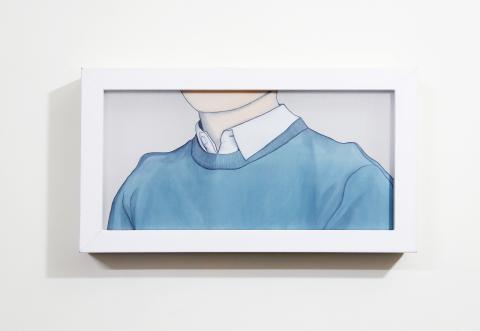
Photo Courtesy of Mumu Gallery
TKG+ is opening a solo exhibition today by Taiwanese artist Chou Yu-cheng (周育正). The artist made international headlines in March this year for his larger than life installation of tableware at the Hong Kong Art Basel. Chou’s show at TKG+ is a continuation of his ongoing project about cleanliness. Reflecting upon how the process of modernization shapes human perception and values, Chou explores the theme of hygiene as a “rather abstract yet feasible standard for modernization,” according to the gallery’s press release. The profusely long exhibition title, Chou Yu-cheng: Refresh, Sacrific, New Hygiene, Infection, Clean, Robot, Air, Housekeeping, jackercleaning.com, Cigarette, Dyson, Modern People. III, plays on the culture of hashtags. The exaggerated stream of associated keywords simultaneously confuses and clarifies what the exhibition is about. Highlights in the show include Cloud, Mist, and Field for Sun Dried Noodles, an installation that presents an array of white threads suspended on wooden racks. Refresh, Sacrifice, New Hygiene is white fiberglass plate with minimal decoration. In addition to the works, Chou also attempts to optimize the exhibition space by multiple machine-supported mechanisms of housekeeping, including the use of Dyson purifiers, vacuums, and computer applications that arranges housekeeping services.
■ TKG+ Projects, 4F, 15, Ln 548, Ruiguang Road, Taipei City (台北市瑞光路548巷15號4樓), tel: (02) 2659-0798. Open Tuesdays to Sundays from 11am to 7pm, closed on Mondays
■ Until July 15
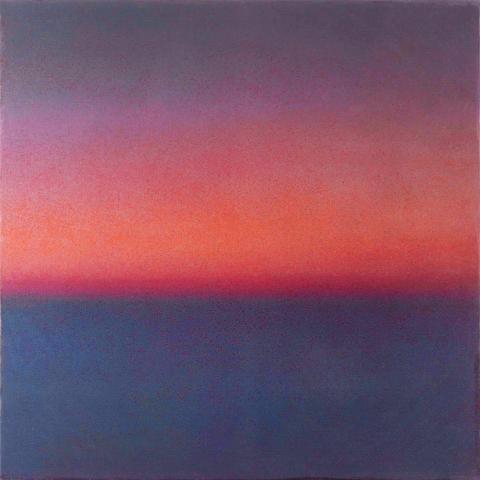
Photo Courtesy of Tina Keng Gallery

In the March 9 edition of the Taipei Times a piece by Ninon Godefroy ran with the headine “The quiet, gentle rhythm of Taiwan.” It started with the line “Taiwan is a small, humble place. There is no Eiffel Tower, no pyramids — no singular attraction that draws the world’s attention.” I laughed out loud at that. This was out of no disrespect for the author or the piece, which made some interesting analogies and good points about how both Din Tai Fung’s and Taiwan Semiconductor Manufacturing Co’s (TSMC, 台積電) meticulous attention to detail and quality are not quite up to

April 21 to April 27 Hsieh Er’s (謝娥) political fortunes were rising fast after she got out of jail and joined the Chinese Nationalist Party (KMT) in December 1945. Not only did she hold key positions in various committees, she was elected the only woman on the Taipei City Council and headed to Nanjing in 1946 as the sole Taiwanese female representative to the National Constituent Assembly. With the support of first lady Soong May-ling (宋美齡), she started the Taipei Women’s Association and Taiwan Provincial Women’s Association, where she

Chinese Nationalist Party (KMT) Chairman Eric Chu (朱立倫) hatched a bold plan to charge forward and seize the initiative when he held a protest in front of the Taipei City Prosecutors’ Office. Though risky, because illegal, its success would help tackle at least six problems facing both himself and the KMT. What he did not see coming was Taipei Mayor Chiang Wan-an (將萬安) tripping him up out of the gate. In spite of Chu being the most consequential and successful KMT chairman since the early 2010s — arguably saving the party from financial ruin and restoring its electoral viability —

It is one of the more remarkable facts of Taiwan history that it was never occupied or claimed by any of the numerous kingdoms of southern China — Han or otherwise — that lay just across the water from it. None of their brilliant ministers ever discovered that Taiwan was a “core interest” of the state whose annexation was “inevitable.” As Paul Kua notes in an excellent monograph laying out how the Portuguese gave Taiwan the name “Formosa,” the first Europeans to express an interest in occupying Taiwan were the Spanish. Tonio Andrade in his seminal work, How Taiwan Became Chinese,